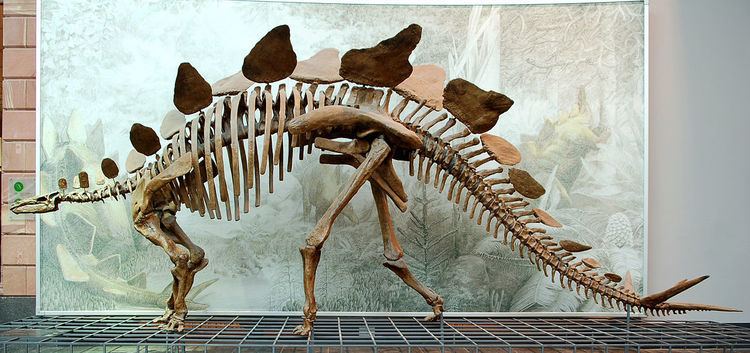 | ||
This timeline of stegosaur research is a chronological listing of events in the history of paleontology focused on the stegosaurs, the iconic plate-backed, spike-tailed herbivorous eurypod dinosaurs that predominated during the Jurassic period. The first scientifically documented stegosaur remains were recovered from Early Cretaceous strata in England during the mid-19th century. However, they would not be recognized as a distinct group of dinosaurs until Othniel Charles Marsh described the new genus and species Stegosaurus armatus in 1877, which he regarded as the founding member of the Stegosauria. This new taxon originally included all armored dinosaurs. It was not until 1927 that Alfred Sherwood Romer implemented the modern use of the name Stegosauria as specifically pertaining to the plate-backed and spike-tailed dinosaurs.
Contents
From the time of their earliest description, the chief mystery surrounding stegosaurs was the function of their distinctive back plates. Marsh originally interpreted them as being plates of armor that would protect against predators. In 1910, Richard Swann Lull would agree with this hypothesis. Charles Whitney Gilmore disagreed in 1914 and argued that the only protection a stegosaur could gain from its plates was to appear intimidatingly larger to potential predators. Nearly forty years later, Davitashvili argued that the plates were too fragile to be used for defense and instead used to attract mates and signal the stegosaur's rank in a social hierarchy.
In the late 1970s, James O. Farlow and others would propose that the thin, blood vessel-rich plates helped absorb or lose body heat, depending on the animal's own physiological requirements. This hypothesis was put forth in a broader context of scientists considering the possibility that dinosaurs may have maintained body temperatures and activity levels similar to those of modern birds and mammals, in which case the plates may have served primarily to shed heat rather than gain it. In the late 1980s Buffrenil and others revived the idea that stegosaur plates were display structures, an interpretation that would continue to find favor from researchers like Main and colleagues into the 21st century.
1840s
1841
1870s
1874
1875
1876
1877
1878
1879
1880s
1880
1881
1884
1887
1890s
1893
1900s
1901
1902
1905
1910s
1910
1911
1912
1914
1915
1916
1920s
1924
1927
1929
1940s
1944
1950s
1951
1957
1960s
1961
1963
1966
1970s
1973
1976
1977
1978
1979
1980s
1980
1981
1982
1983
1984
1985
1986
1987
1987
1987
1990s
1990
1991
1992
1993
1994
1996
1997
1998
1999
2000s
2000
2001
2004
2006
2007
2008
2009
2010s
2015
2016
